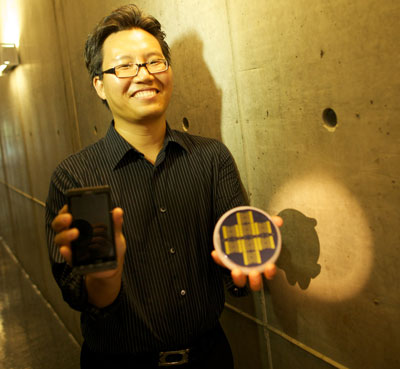| Apr 04, 2012 |
Nanotechnology-equipped cell phones detect harmful airborne substances
|
|
(Nanowerk News) The lab of a University of California, Riverside Bourns College of Engineering professor was named on Tuesday, April 3 after Innovation Economy Corporation, a Riverside company that plans to commercialize his research focused on using mobile devices, such as cell phones, to detect harmful airborne substances in real-time.
|
|
The technology being developed by Nosang Myung, professor and chair of the Department of Chemical and Environmental Engineering, and Innovation Economy Corporation has the potential to be adapted in many industries. These include agriculture (detecting concentrations of pesticides), industry (monitoring evaporation and leaks when using or storing combustible gases), homeland security (warning systems for bio-terrorism) and the military (detecting chemical warfare agents).
|
 |
| Nosang Myung holds the devices that he hopes will allow for the detection of harmful airborne substances in real-time.
|
|
"This collaborative relationship is key to ensuring research conducted in our laboratories can be commercialized." Myung said.
|
|
Reza Abbaschian, dean of the Bourns College of Engineering, said he is appreciative of Innovation Economy Corporation's support of the research.
|
|
"We are equally appreciative of the support they offer through their mission of connecting our faculty with government and industry and identifying ways to commercialize their discoveries for the benefit of society," Abbaschian said.
|
|
Myung's research is licensed by start-up company Nano Engineering Applications, Inc., which was created and funded by Innovation Economy Corporation.
|
|
Nano Engineering Applications focuses on commercializing patent pending, air-borne chemical detection technology. The company's cost-effective and scalable fabrication techniques allow research to be transformed into portable devices that detect minute quantities of harmful air-borne substances.
|
|
"This is a truly a unique opportunity to collaborate with a world class research university to transform untapped innovative research into solutions for the global marketplace," said Amro Albanna, Chairman and CEO of Innovation Economy Corporation.
|
|
The UC Riverside/Innovation Economy Corporation alliance moves the company closer to integrating toxin detection capabilities with mobile devices, including cell phones that can interface global positioning satellite systems.
|
|
The technology uses functionalized carbon nanotubes that are 100,000 times finer than human hair and when functionalized are able to detect a multitude of targeted air-borne substances.
|
|
UCR and Innovation Economy Corporation efforts are supported by the city and county of Riverside.
"This model is one of the crowning achievements in our quest to continue to be recognized as one of the most intelligent communities in the world," Mayor Ron Loveridge said.
|
|
John Tavaglione, chairman of the Riverside County Board of Supervisors, said: "This ceremony is yet another example of way Riverside County has become a global leader in innovative business growth."
|
|
|

